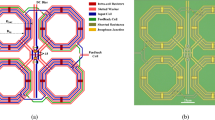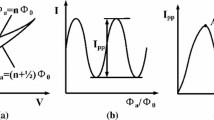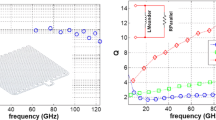Abstract
We calculate the signal-to-noise ratio in a dc SQUID system as a function of source impedance, taking into account the effects of current and voltage noise sources in the SQUID. The optimization of both tuned and untuned voltmeters and magnetometers is discussed and typical sensitivities are predicted using calculated noise spectra. The calculations are based on an ideal symmetric dc SQUID with % MathType!MTEF!2!1!+-% feaafeart1ev1aaatCvAUfeBSjuyZL2yd9gzLbvyNv2CaerbuLwBLn% hiov2DGi1BTfMBaeXatLxBI9gBaerbd9wDYLwzYbItLDharqqtubsr% 4rNCHbGeaGqiVu0Je9sqqrpepC0xbbL8F4baFfea0dXde9vqpa0lb9% cq0dXdb9IqFHe9FjuP0-iq0dXdbba9pe0lb9hs0dXda91qaq-xfr-x% fj-hmeGabaqaciGacaGaaeqabaWaaeaaeaaakeaacqaHYoGycqGH9a% qpcaaIYaacbaGaa8htaiaa-LeadaWgaaWcbaacbiGaa4hmaaqabaGc% caGGVaGaeuOPdy0aaSbaaSqaaiaa+bdaaeqaaOGaeyypa0JaaGymaa% aa!3D23!\[\beta = 2LI_0 /\Phi _0 = 1\] and moderate noise rounding % MathType!MTEF!2!1!+-% feaafeart1ev1aaatCvAUfeBSjuyZL2yd9gzLbvyNv2CaerbuLwBLn% hiov2DGi1BTfMBaeXatLxBI9gBaerbd9wDYLwzYbItLDharqqtubsr% 4rNCHbGeaGqiVu0Je9sqqrpepC0xbbL8F4baFfea0dXde9vqpa0lb9% cq0dXdb9IqFHe9FjuP0-iq0dXdbba9pe0lb9hs0dXda91qaq-xfr-x% fj-hmeGabaqaciGacaGaaeqabaWaaeaaeaaakeaaiiGacqWFOaakcq% WFtoWrcqWF9aqpcqWFYaGmcqaHapaCcaWGRbWaaSbaaSqaaiaadkea% aeqaaGqaaOGaa4hvaiaac+cacaGFjbWaaSbaaSqaaerbbjxAHXgaiu% GacaqFWaaabeaakiab-z6agnaaBaaaleaacaqGGaacbiGaaWhmaaqa% baGccqGH9aqpcaaIWaGaaiOlaiaaicdacaaI1aGaaiykaaaa!471A!\[(\Gamma = 2\pi k_B T/I_0 \Phi _{{\rm{ }}0} = 0.05)\], where Φ0 is the flux quantum, T is the temperature, L is the SQUID inductance, and I 0 is the critical current of each junction. The optimum noise temperatures of tuned and untuned voltmeters are found to be 2.8(ΩL/R)T and 8(ΩL/R)T (1 + 1.5α2 + 0.7α4)1/2/α2 respectively, where Ω/2π is the signal frequency, assumed to be much less than the Josephson frequency, and α is the coupling coefficient between the SQUID and its input coil. It is found that tuned and untuned magnetometers can be characterized by optimum effective signal energies given by (16k B TLE/α2 R)[1 + (1 + 1.5α2 + 0.7α2)1/2 + 0.75α2] and 2kB T iRiB/Ω2 L p respectively, where B is the bandwidth, R i is the resistance representing the losses in the tuned circuit at temperature T i and L p is the inductance of the pickup coil.
Similar content being viewed by others
References
V. R. Radhakrishnan and V. L. Newhouse, J. Appl. Phys. 42, 129 (1971).
J. Clarke, Proc. IEEE 61, 8 (1973).
A. Davidson, R. S. Newbower, and M. R. Beasley, Rev. Sci. Instr. 45, 838 (1974).
J. H. Claasen, J. Appl. Phys. 46, 2268 (1975).
J. Clarke, in Superconductor Applications: SQUIDS and Machines, B. B. Schwartz and S. Foner, eds. (Plenum, 1977), p. 67.
V. V. Danilov, K. K. Likharev, O. V. Sniguiriev, and E. S. Soldatov, IEEE Trans. Magn. MAG-13, 240 (1977).
A. V. Gusev and V. N. Rudenko, Zh. Eksp. Teor. Fiz. 74, 819 (1978) [Sov. Phys.—JETP 47, 428 (1978)].
F. Bordoni, P. Carelli, I. Modena, and G. L. Romani, J. Phys. (Paris) 39, C6–1213 (1978).
M. B. Simmonds, W. A. Fertig, and R. P. Giffard, IEEE Trans. Mag. MAG-15, 478 (1979).
W. S. Goree and V. W. Hesterman, in Applied Superconductivity, Vol. 1, V. L. Newhouse, ed. (Academic Press, New York, 1975).
G. Ehnholm, J. Low Temp. Phys. 29, 1 (1977).
R. P. Giffard and J. N. Hollenhorst, Appl. Phys. Lett. 32, 767 (1978).
G. Ehnholm, S. T. Islander, P. östman, and B. Rantala, J. Phys. (Paris) 39, C6–1206 (1978).
C. D. Tesche and J. Clarke, J. Low Temp. Phys. 29, 301 (1977).
C. D. Tesche and J. Clarke, J. Low Temp. Phys., this issue, preceding paper.
J. Clarke, W. M. Goubau, and M. B. Ketchen, J. Low Temp. Phys. 25, 99 (1976).
M. B. Ketchen, J. Clarke, and W. M. Goubau, in Future Trends in Superconductive Electronics, B. Deaver, C. Falco, J. Harris, and S. Wolf, eds. (AIP Conference Proceedings No. 44; Am. Inst. Phys., 1978), p. 22.
R. A. Webb, R. P. Giffard, and J. C. Whealley, J. Low Temp. Phys. 13, 383 (1973).
Author information
Authors and Affiliations
Additional information
This work was supported by the Division of Materials Sciences, Office of Basic Energy Sciences, U.S. Department of Energy, and by the U.S. Office of Naval Research.
Guggenheim Fellow.
Rights and permissions
About this article
Cite this article
Clarke, J., Tesche, C.D. & Giffard, R.P. Optimization of dc SQUID voltmeter and magnetometer circuits. J Low Temp Phys 37, 405–420 (1979). https://doi.org/10.1007/BF00119198
Received:
Issue Date:
DOI: https://doi.org/10.1007/BF00119198




